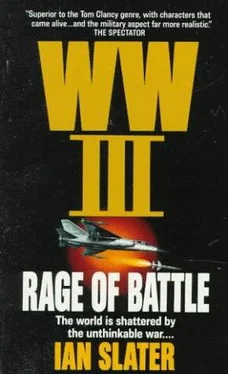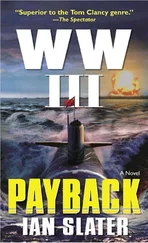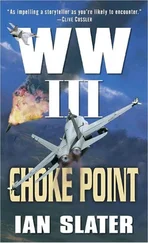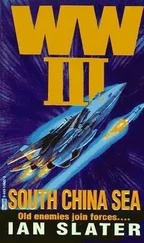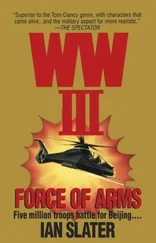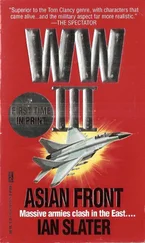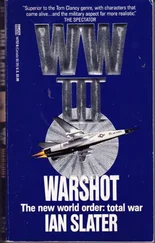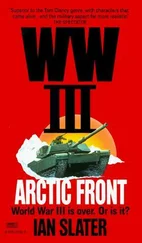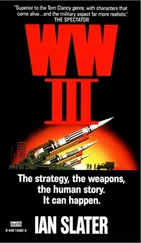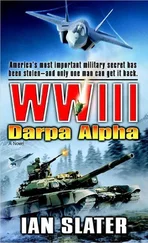Ian Slater - Rage of Battle
Здесь есть возможность читать онлайн «Ian Slater - Rage of Battle» весь текст электронной книги совершенно бесплатно (целиком полную версию без сокращений). В некоторых случаях можно слушать аудио, скачать через торрент в формате fb2 и присутствует краткое содержание. Год выпуска: 1991, ISBN: 1991, Издательство: Ballantine Books, Жанр: Триллер, на английском языке. Описание произведения, (предисловие) а так же отзывы посетителей доступны на портале библиотеки ЛибКат.
- Название:Rage of Battle
- Автор:
- Издательство:Ballantine Books
- Жанр:
- Год:1991
- ISBN:0-345-46514-8
- Рейтинг книги:3 / 5. Голосов: 1
-
Избранное:Добавить в избранное
- Отзывы:
-
Ваша оценка:
- 60
- 1
- 2
- 3
- 4
- 5
Rage of Battle: краткое содержание, описание и аннотация
Предлагаем к чтению аннотацию, описание, краткое содержание или предисловие (зависит от того, что написал сам автор книги «Rage of Battle»). Если вы не нашли необходимую информацию о книге — напишите в комментариях, мы постараемся отыскать её.
Rage of Battle — читать онлайн бесплатно полную книгу (весь текст) целиком
Ниже представлен текст книги, разбитый по страницам. Система сохранения места последней прочитанной страницы, позволяет с удобством читать онлайн бесплатно книгу «Rage of Battle», без необходимости каждый раз заново искать на чём Вы остановились. Поставьте закладку, и сможете в любой момент перейти на страницу, на которой закончили чтение.
Интервал:
Закладка:
The UCV speed was now showing twenty knots on the digital readout — too fast for most noncombat vessels. But Brentwood knew that in trying to maintain the U.S. Navy’s “rollover” strategy — rolling over all obstacles, including Russian sub packs, in order to get vital resupply to NATO and Europe — the United States had made up for lost time with an industrial miracle that even dwarfed previous Japanese achievements. The industrial “miracle,” spurred on by uncertainty about the level of Japan’s commitment to the war effort, beyond her helping to ferry American troops across to Korea, was that the U.S. East Coast shipyards and those in San Diego were producing “prefab thirty-thousand-ton merchantmen,” called “Leggo ships” by the submarine crews, at the rate of one every seven days. It wasn’t as fast as the one Liberty ship every four days achieved by the American Kaiser Shipyards in World War II, but for a computer age, it was impressive, the Leggo ships stronger because of the laser spot welding, and faster.
Brentwood put it to Zeldman and the RO that it was quite possible the noise they were hearing was that of a Leggo. With the merchantmen rolling off the slipways at more than three a week, there was no way, he pointed out, that Roosevelt’s computer could have all Leggo noise signatures in its memory. Each time the subs returned from patrol, they were routinely issued the top secret taped signatures of the thirty-five Leggos built in the yards during the patrol. Besides, the moment the merchantmen were completed, they were pressed into service, without the normal time set aside for sea trials during which the noise signatures of ships were normally taped and refined to register any changes made by the yard-birds.
“Could be one of ours,” conceded Zeldman, watching Brentwood’s expression, trying to anticipate which course of action he would take.
“Forty-three hundred and closing,” came Sonar’s coolly modulated tone. The ship was coming right for them. In just over seven minutes it would be directly over the Roosevelt, now lying still, on listening mode only.
Brentwood ordered everything closed down except the “coffee grinder,” the reactor at the very heart of the sub that not only powered the Sea Wolf but which would take hours to fire up. Zeldman was worried that Brentwood was placing too much faith in the anechoic paint layer on the hull, which absorbed sonar pulses from another source, thus minimizing, sometimes eliminating, echo ping and so denying a hunter any “noise scent” at all.
Suddenly, with each man silent, rigid, as if welded to his post, the submarine seemed to shrink inside. It was true that for the men who had experienced life in the old diesel-electric subs and for one or two who had served, when very young, in the last boats of World War II, the Sea Wolf was infinitely more spacious. Curtained for privacy, individual bunks in nine-man dormitories, good-sized lockers beneath, rack space large enough to hang a full dress uniform, a soundproofed audio booth and video room for two movies a week, the modern Sea Wolf was a limousine compared to a standard sedan. Still, for most of the crew, who didn’t know the old pigboats, who hadn’t experienced what it was like at the end of your watch to have to roll into the sweat-soaked bunk of your replacement, and, except for the cook and the oiler, to be allowed only one three-minute shower a week, the Roosevelt was still crowded. Every now and then even a fully trained crewman would crack from what was euphemistically called DCS — developed claustrophobia syndrome.
As he listened to the heavy, gut-punching throb of the approaching vessel, it occurred to the hospital corpsman that perhaps Evans hadn’t had the DTs after all. Maybe he’d cracked under the strain of such claustrophobia. No matter how much bigger the Roosevelt was, compared to the old pigboats, it was still a submarine, with every available space jammed with equipment, including lead shot which could be jettisoned to accommodate new equipment so as not to alter the sub’s buoyancy. The corpsman knew that by any landlubber’s reckoning, the sub was still a long, steel coffin, and every man aboard knew that below her “crush” depth of three thousand feet, the enormous pressure driving her toward the bottom at over a hundred miles an hour, the sub would implode — flattened like a beer can beneath a boot.
“Two thousand and closing,” reported Sonar, his voice not so steady now, and hoarse, the sound of the UCV’s props increasing, having changed from a deep, rhythmic pulse to a churning noise that now seemed to be coming at them from every direction.
“Torpedoes ready?” asked Brentwood.
“Ready, sir,” confirmed Zeldman.
Brentwood glanced up at the fathometer. They were in shallower water. It made him more vulnerable to shock waves from any explosion.
“Set forward one and two for SI. Stern five and six for SI,” ordered Brentwood, quietly and distinctly, his command heard clearly in both forward and aft torpedo rooms, the fish being set for SI, or sensor impact, the unknown surface vessel now so close that the trailing wires which normally ran back from the torpedoes to the sub need not be used — the close proximity of the oncoming ship in effect a point-blank target for the twenty-eight-mile Mark-48s.
“Fifteen hundred. Closing,” came Sonar’s voice. “Speed increasing to twenty-seven knots. Most likely a cruiser, Captain. Friendly or not, I can’t tell.”
The choice for Brentwood was clear and stark. Under the authority of chief of naval operations, he could risk attacking any UCV if the UCV had not been identified by signature. In the cruel equation of war, the risk of sinking a “friendly” did not come near to the cost of losing a Sea Wolf, with its capacity as “platform of last resort” to take out a minimum of twenty-four major Soviet cities and/or ICBM “farms” from over two and a half thousand miles away. Yet Brentwood knew that even if the ship wasn’t using a chopper-dangled sonar mike because of the vicinity of its mother ship’s noise, if he fired, the UCV’s on-board sonar would instantly have his precise position. He could then expect to be dumped on by a cluster of “screamers,” as the U.S. sailors called the Soviet RBU— Raketnaya Bombometnaya Ustanovka— antisubmarine rockets. Fired in paired sequence from twelve-barrel horseshoe-configuration launchers, the five-foot-long, forty-two-pound warheads would rip the Roosevelt apart. The later models, being fitted by the Soviets with World War II-type Stuka dive-bomb whistles, were given the name “screamers,” and their noise, traveling much faster underwater than in air, struck deep into the collective psyche of all NATO submariners.
“Thirteen hundred yards and closing.”
The signature computer was still running, maddeningly indecisive, flashing orange bars across its green screen, indicating possible “enemy” match-ups with a plus or minus ten percent error in noise signatures. But only if the orange stripes went to kit-kats, solid brown stripes, would it mean an enemy vessel for sure — light blue bars representing possible “friendlies,” solid blue for confirmed. “One thousand and closing. Still stripe orange.” Zeldman said nothing, jaw clenched, his reflection staring back at him in the computer’s screen, guessing that if Brentwood had decided to risk the Roosevelt’s silence, he would have fired already. Instead it seemed he was gambling that the surface vessel — a cruiser, by the multiple echoes coming in via Roosevelt’s towed sensor array — was now having its active sonar blanketed in the shallower water by the thrashing of its own props. If so, the cruiser might pass over them, waiting for a clearer echo.
Читать дальшеИнтервал:
Закладка:
Похожие книги на «Rage of Battle»
Представляем Вашему вниманию похожие книги на «Rage of Battle» списком для выбора. Мы отобрали схожую по названию и смыслу литературу в надежде предоставить читателям больше вариантов отыскать новые, интересные, ещё непрочитанные произведения.
Обсуждение, отзывы о книге «Rage of Battle» и просто собственные мнения читателей. Оставьте ваши комментарии, напишите, что Вы думаете о произведении, его смысле или главных героях. Укажите что конкретно понравилось, а что нет, и почему Вы так считаете.
